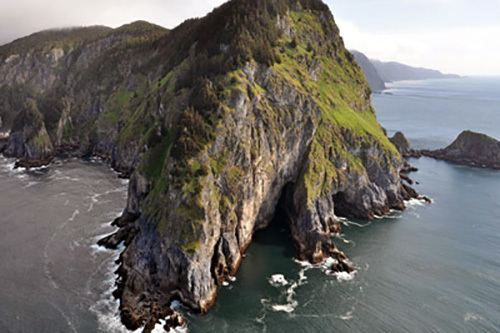 | ||
Coronation Island is located off the northwest coast of Prince of Wales Island, south of Kuiu Island, and north of Noyes Island. The nearest full service community is Craig, Alaska. The island is also home to the Coronation Island Wilderness, which encompasses 19,232 acres (78 km2).
Contents
- Map of Coronation Island Alaska USA
- Island AccessEdit
- GeographyEdit
- WildlifeEdit
- FloraEdit
- CultureEdit
- General Wilderness ProhibitionsEdit
- References
Map of Coronation Island, Alaska, USA
Island AccessEdit
The island is accessible by boat or float plane. People wanting to visit should be aware of winds and surf.
GeographyEdit
Coronation Island is an island that has the Pacific Ocean to its south and southwest, Iphigenia Bay to its southeast, Sumner Strait to its east and northeast, and Chatham Strait to the west and northwest. To the North is Kuiu Island. To the east is Warren Island. Coronation Island has seven high peaks: Needle Peak, Aats Peak, Pin Peak, and four other peaks that are not named. Coronation Island has five bays: Egg Harbor, Alikula Bay, Aats Bay, Gish Bay, and Windy Bay. The island is surrounded by rocky areas, a few sandy areas, and a handful of coral reefs. The island is made largely of limestone. Colander Cave was found in 2001.
WildlifeEdit
Common animals on Coronation Island would include black bears, black-tailed deer, bald eagles, wolves, sea otters, Steller's sea lions, harbor seals, and humpback whales.
Fish and shellfish that inhabit the water around the island include: king salmon, red salmon, silver salmon, pink salmon, chum salmon, halibut, lingcod, Pacific cod, a variety of rock fish, greenling, rat fish, dog sharks, dungeness crab, tanner crab, king crab, shrimp, prawns, scallops, abalone, clams, and jellyfish. There have also been reported sightings and catchings of great white sharks that have traveled up on warm currents.
FloraEdit
The island has Sitka spruce and western hemlock. The rest of the island vegetation is lush and varied. The ocean around the island ranges from 51F to 55F and supports a handful of coral reef areas.
CultureEdit
The Henyakwan Tlingit traditionally used Coronation Island, and would often camp in Egg Harbor while awaiting fair weather to travel out to the Hazy Islands, where they would gather bird eggs. A lead mine operated on the west shore of Egg Harbor from the early 1900s until the late 1960s.
General Wilderness ProhibitionsEdit
Motorized equipment and equipment used for mechanical transport is generally prohibited on all federal lands designated as wilderness. This includes the use of motor vehicles, motorboats, motorized equipment, bicycles, hang gliders, wagons, carts, portage wheels, and the landing of aircraft including helicopters, unless provided for in specific legislation. In a few areas some exceptions allowing the use of motorized equipment or mechanical transport are described in the special regulations in effect for a specific area. Contact the Forest Service office for more specific information.
These general prohibitions have been implemented for all national forest wildernesses in order to implement the provisions of the Wilderness Act of 1964. The Wilderness Act requires management of human-caused impacts and protection of the area's wilderness character to ensure that it is "unimpaired for the future use and enjoyment as wilderness." Use of the equipment listed as prohibited in wilderness is inconsistent with the provision in the Wilderness Act which mandates opportunities for solitude or primitive recreation and that wilderness is a place that is in contrast with areas where people and their works are dominant.
